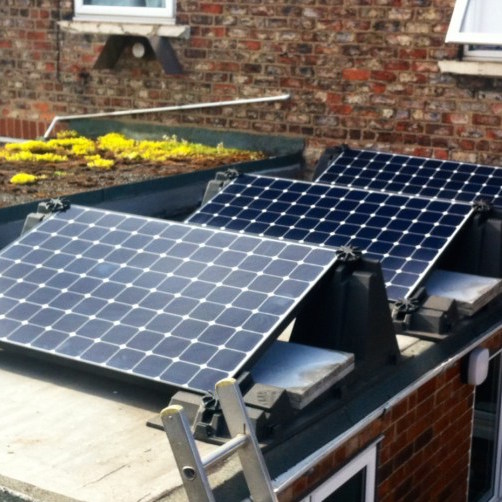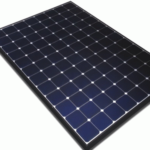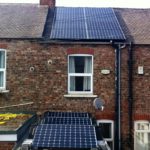To PV or not to PV? – are photovoltaic panels worth it on a small roof?
I thought we couldn’t afford photo-voltaics (PVs) on our budget. They were ruled out with a sad face and without much contemplation at the beginning of the project, but after a little brainwave ~9 months into the project I worked a way to get them without the outlay & making use of both the main roof and extension flat-roof. We are proud of our panels and feel they are one of the biggest bits of the “eco” renovation.
The idea – Split array & Scalability
As a small terrace, there are significant roof space restrictions so we had to get round this to allow for the panels. We have a small roof (~9m2) and a little extension with a flat roof of ~6m2, so there’s only a little space to get our capacity in. A PV installation of 4kW peak – the typical install size due to government tariffs – at the time we looked (Feb-Mar 13) came in range ~£5-7k, with the established 180/240W panels coming in at the lower end to newer more efficient/higher capacity panels coming in at the upper end. As the PV industry loves to tell us, the costs of PVs have dropped dramatically over the past decades (pic. below). However their economic viability as technology in the UK is currently dependant on the Government’s renewables uptake incentive – feed-in-tarrifs (FITs) – and these have been decreased in stages since their introduction. So, combined with local effects, each install’s economic case is unique dependant on when it is undertaken. Our window was with FITs at 15.44 p per unit generated (kWh) & an export tariff of 4.6 p per unit (kWh) transferred to the grid. So now the job was to work out the difference between different systems and get some people to quote for it.

Would the Sun shine on us?
To see whether the Sun will shine on your PV plan, there are lots of useful free resources out there like the Centre for Alternative Technology (CAT), the Joint Research Centre (JRC) PV and the energy saving trust (EST) tools. They take a few small pieces of info – like roof size, angle and location – and combine this with weather data to convert this into payback stats for energy and money. I used 4 in the end (links at bottom) to get my head round the project. This gave us a great approximation for the project and we soon felt that if we could find a way to finance the panels it would not only help us reduce our bills, but contribute to renewable energy production & help provide some payback for all the work we’ve done on our little place. We had a think about the local issues, like avoiding shading on the panels from chimney pots & neighbours roofs. The siting had to carefully considered and this was especially the case of any rack mounted panels.
Spec’ing it out
We needed high capacity panels to fit the 4kW worth we were aiming for, which narrowed our search down to three panels (below). This was done via online reviews, installers/buyers comments (YouGen), old photon magazine listing (unfortunately now bust) and on-line reference databases (e.g. direct industry) for the individual panels.
Then we asked four companies to quote for this split array system; the companies we selected had to have micro-generation certificate scheme (MCS) registration to allow us to get FITs. We choose these through Google, YouGen, & EcoExpert. Surprisingly only two of them were willing to deal with the complexity of the split array, and one company was quickly our favourite for their responses to my excessive questions. There are lots of options when it come to panels, and the four installers who quoted all had their own favourites. Pleasingly these did seem to tally with what the independents (photon magazine) were saying, and we had the choice narrowed to REC vs. SunPower to meet our high capacity with low area requirements. In the end it was a combination of warrantee, entirely black aesthetics, and physical size that made the decision, the SunPower’s 25 year extensive warrantee making it a firm winner in my thoughts.
Cost
The cost was the original stumbling block and the rather odd split array only pushed this cost up. My research had shown that install/labour/inverter costs outweigh the modules’ cost, so a larger array would be cheaper per kW and provide a better payback. I started growing jealous of anyone with a large east/west/south facing roof as this would let them use cheap panels and lots of them. However clearly from the quotes, the install was still very much worthwhile, so I looked into how to pay for the system. I found ways to avoid a prohibitive up-front cost through eco-loans (e.g. home eco improvement loan or company finance) and ended up securing the money at a low interest rate by having it added onto the mortgage.
Install
When it came down to it, the install was done in a fast and efficient way – it only really took a day. Our neighbour kindly allowed us to reduce the height of his drainpipe (along with ours) to ensure the panel’s performance, and then we were off! I’ve not looked back (until this article!) and half a year & ~1500kWh later (see daily production graph below) we can only say we’re more than pleased…

I am next going to integrate a mini weather station into the system to be able to analyse the panel performance in context, but that will be separate blog entry.
Here are some refs/links :
- JRC PV tool – Detailed & technical assessment tool
- CAT PV tool – Another very easy to use and well explained tool
- Solar Pannel UK PV solar tool
- Energy saving trust (EST) PV tool
- One Planet Solar – Our PV installers
- Detailed overview of PVs
- Deemed versus Metered – YouGen – Independent essential & detailed info
- Legal aspects – Gov Planning portal
- Evo-Energy – Example of company finance for panels
- SunPower panels – our chosen panels
- Photon Magazine bust – previous goto source
- Online panel database – Direct industry
There are also more general relevant links on my links page.
Disclaimer: I’ve tried to be as accurate as I can, and when prices have been quoted those were available openly on the date of publication. Obviously I take no responsibility for any of the prices quoted or products mentioned, and in no way am I providing financial advice or recommending a particular course of action. If you see any errors/broken links/have any comments please just drop me and email or comment.













You may find it interesting to join Sheffield Solar Farm database of installations around the UK – they have probably the most comprehensive data set in the country now simply from asking people to record and log performance at least monthly
Hello Andy,
Thanks for recommending sheffield Solar Farm. I contribute data currently, and am trying to spread the word a little bit too, so its great to see others advocating it.
Its a great resource, i’m always interested to see what they do with the data.
Thanks,
Tomas
Excellent post, really informative, thank you
Hiya, I am really glad I’ve found this information. Today bloggers publish just about gossip and internet stuff and this is really irritating. A good web site with exciting content, that is what I need. Thanks for making this website, and I will be visiting again. Do you do newsletters? I Can’t find it.
Cheers! There is an (email) subscribe form on lefthand menu panel.